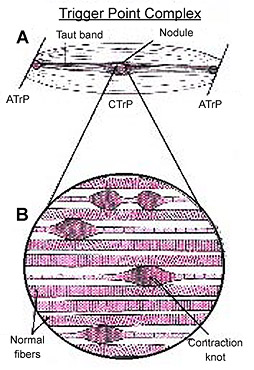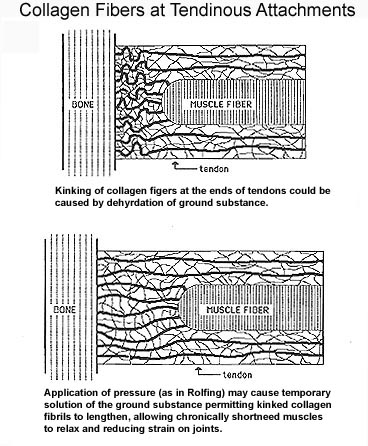 |
Tandem Point(SM) Therapy:
An integrated acupressure approach for myofascial pain by Rena K. Margulis Presented to Rehabilitation Medicine Grand Rounds National Institutes of Health March 17, 2000 |
|
Many of you are familiar with trigger points. For those of you who are not, here is a quick review of definitions. "Myofascial Trigger Point (clinical definition of a central trigger point): A hyperirritable spot in skeletal muscle that is associated with a hypersensitive palpable nodule in a taut band. The spot is painful on compression, and can give rise to characteristic referred pain, referred tenderness, motor dysfunction, and autonomic phenomena"(1) emphasis mine. What this means is that when you, the clinician, suspect a trigger point, you can palpate for it. It will be hard. When you locate it, the patient will say "ouch." "Myofascial Trigger Point (etiological definition of a central trigger point): A cluster of electrically active loci, each of which is associated with a contraction knot and a dysfunctional motor endplate in skeletal muscle"(1) emphasis mine. What is important is that a trigger point is electrically different from the surrounding tissue. The same is true for acupuncture points. These facts suggest a possible mechanism for the effectiveness of Tandem Point therapy, which will discussed later. "Attachment Trigger Point: A trigger point at the musculotendinous junction and/or at the osseous attachment of the muscle that identifies the enthesopathy caused by unrelieved tension characteristic of the taut band that is produced by a central trigger point."(1) "Key Myofascial Trigger Point: A trigger point responsible for activating one or more satellite trigger points. Clinically, a key trigger point is identified when inactivation of that trigger point also inactivates the satellite trigger point."(1) "Satellite Myofascial Trigger Point: A central myofascial trigger point that was induced neurogenically or mechanically by the activity of a key trigger point. . . . A satellite trigger point may develop:
C. Chan Gunn, M.D., has also found a linkage between trigger points and contractures in other muscles on the same myotome, and I will discuss that linkage further later. "Taut Band: The group of tense muscle fibers extending from a trigger point to the muscle attachments. The tension of the fibers is caused by contraction knots that are located in the region of the trigger point."(1) "Referred (Trigger-Point) Pain: Pain that arises in a trigger point, but is felt at a distance, often entirely remote form its source. The pattern of referred pain is reproducibly related to its site of origin. The distribution of referred trigger-point pain rarely coincides entirely with the distribution of a peripheral nerve or dermatomal segment."
This diagram is based on photographs taken under light microscopy of canine muscle tender spots that meet trigger point criteria. The diagram shows attachment trigger points at each end of one muscle and a central trigger point. Looking within the trigger point, you can see multiple contraction knots with contracted sarcomeres. David Simons notes that oxygen is missing from a trigger point. Water and ions may also be missing.
Painful, palpable nodules may appear in tendons, especially at the periosteal attachments. During Tandem Point therapy, these nodules feel and act just like trigger points. I use them interchangeably with trigger points in muscles. [During Rolfing(TM) sessions, I have observed that the release of fascial restrictions is facilitated by pressing acupuncture points.] Recent research reveals that trigger points are electrically different from the surrounding tissue. Electromyograph studies show that active trigger points have (a) intermittent and variable high-amplitude spike potentials, and (b) a consistently present, lower amplitude noise-like component, called by David Simons spontaneous electrical activity.(2) While Simons discusses this electrical activity as being diagnostic or characteristic of a trigger point, I would like you to consider that this electrical activity may be the most important feature of the trigger point, the feature that perpetuates the trigger point.
|

